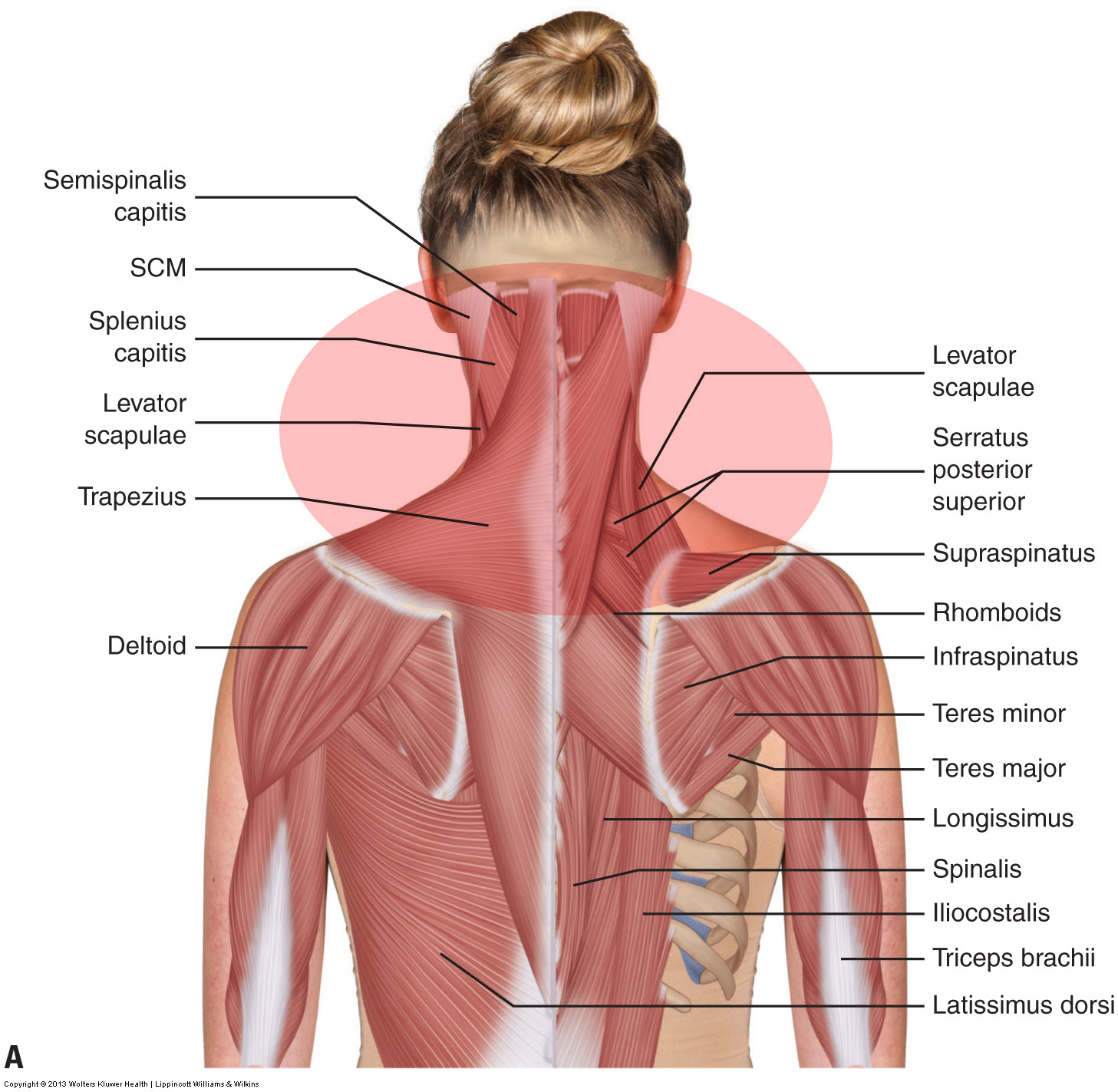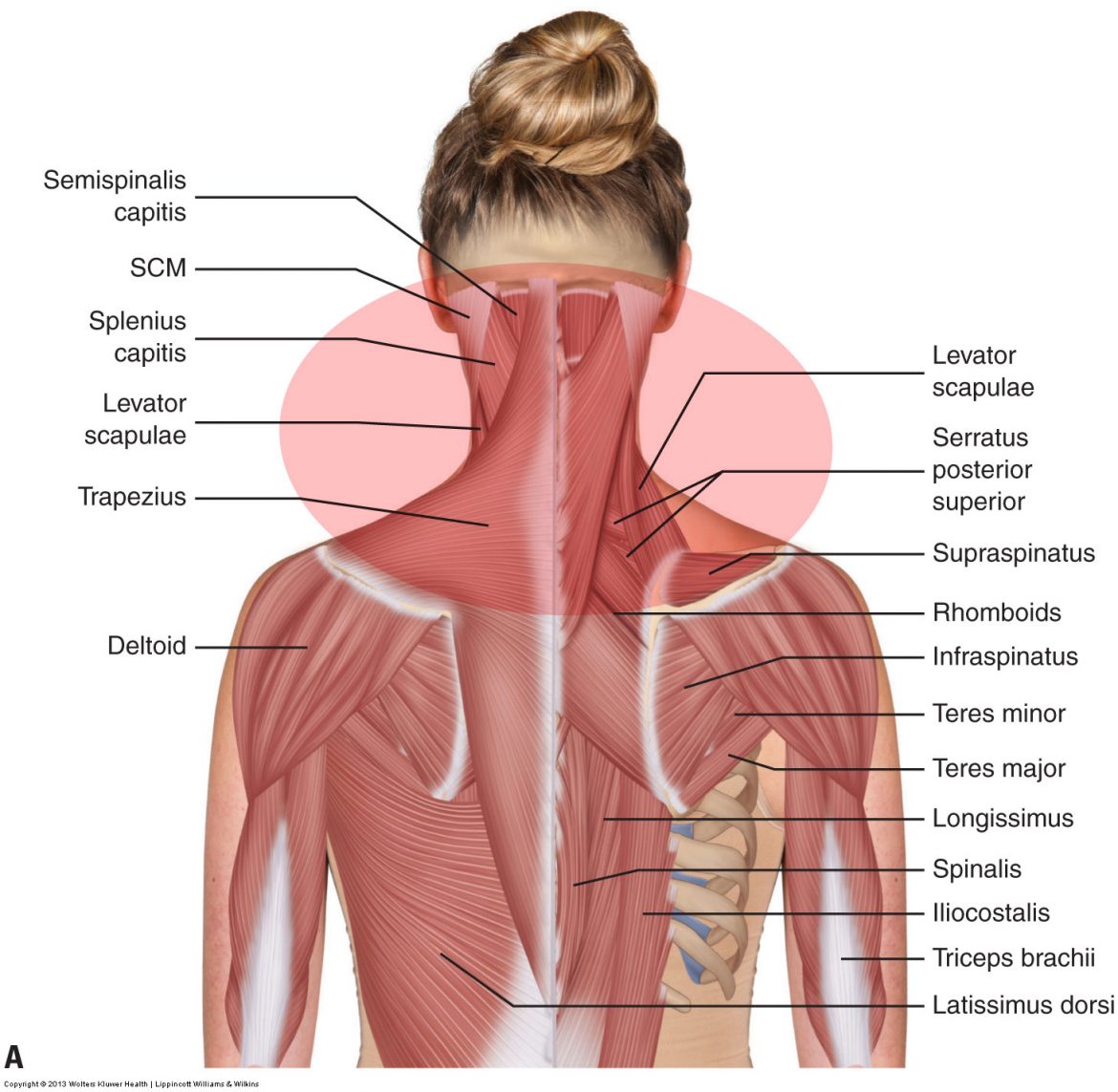Muscle Spasming of the Neck – Introduction:
Muscle spasming of the neck is likely the most common musculoskeletal complaint that exists. Indeed it is rare to find a client/patient whose neck is not tight.

Posterior view of the muscles of the neck. Permission: Joseph E. Muscolino. Advanced Treatment Techniques for the Manual Therapist: Neck (2013).
The musculature of the neck (cervical spine) can be divided into anterior and posterior compartments. All muscles that cross the neck posteriorly can extend the neck at the spinal joints; all muscles that cross the neck anteriorly can flex the neck. It is the extensor musculature of the posterior compartment that is most often tight and symptomatic. The musculature of the neck can be further subdivided into four quadrants. The muscles of the posterior right quadrant can extend and right laterally flex; the muscles of the posterior left quadrant can extend and left laterally flex; the muscles of the anterior right quadrant can flex and right laterally flex; and the muscles of the anterior left quadrant can flex and left laterally flex.
Cervical rotation musculature is not so neatly divided by compartments or quadrants. There are both ipsilateral and contralateral rotators in the posterior quadrants; and there are contralateral rotators in the anterior quadrants. Therefore, if someone were to have restricted left rotation because of a tight right rotator muscle for example, that tight right rotator muscle could be in the right or the left posterior compartment or the left anterior compartment.
Muscle spasming is a term that describes increased active muscle tone when the muscle is at rest; in other words, increased sliding filament contraction. Muscle spasming can be global, in which case the entire muscle or a large portion of it is tight; or it can involve myofascial trigger points and taut fibers. The term cramping is often, but not always, used synonymously with spasming. The term strain is also often used to describe tight musculature, but technically a strain should involved tearing of muscular tissue.
Causes:
Extensor musculature of the posterior neck is often tight because it is so often used. To borrow a common phrase of renowned author and lecturer Leon Chaitow, it can be said that posterior neck musculature is “used, overused, misused, and abused.” The reasons are two-fold: 1) Its role in neck movement and posture, and 2) Its role in upper extremity movement and posture.
If the center of weight, in other words the center of gravity of the head is balanced over the trunk, it does not require contraction of neck musculature to hold its position. However, the second that we flex our head and neck far enough so that the center of gravity of the head is over thin air, gravity should make it fall into flexion until the chin hits or comes close to the chest. The reason this does not happen is that the head is prevented from falling into flexion by contraction of the cervical extensor musculature. The postural distortion pattern of holding the head out in front of the body is referred to protraction of the head or forward head carriage. This postural distortion very often follows the postural distortion pattern of upper crossed syndrome in which the thoracic spine is hyperkyphotic. A hyperkyphotic thoracic spine creates a pedestal upon which the cervical spine is projected anteriorly resulting in forward head carriage. I like to say to patients: “If you want your neck to feel better today, I will work it today. If you want your neck to feel better in six months, I need to also work your thoracic spine.” If the client has a hyperkyphotic thoracic spine, it is essential to work the patient’s/client’s thoracic spine in conjunction with their cervical spine (neck) for long-lasting improvement.
If the imbalanced head posture of partial neck flexion is held for long periods of time, the posterior extensor musculature must chronically isometrically contract. Isometric contraction can restrict venous blood return resulting in congestion of waste products in the tissues. If the contraction is hard enough, it can also restrict arterial blood supply, resulting in ischemia to the distal tissues, causing myofascial trigger points. The net result is pain and spasming. Unfortunately, most activities that we do are down in front of us, usually requiring or encouraging a posture of neck flexion. Examples include such diverse tasks as reading, writing, using a smart phone or tablet, cutting vegetables, and tending to a baby.
Muscle spasming of the neck can also occur due to motions and postures of the upper extremity. Humeral motions at the glenohumeral joint require scapular motions at the scapulocostal joint (this is known as scapulohumeral rhythm). Two of the major muscles of the posterior neck, the trapezius and levator scapulae, attach to the scapula and therefore contract with scapular functioning. For example, whenever the humerus is flexed or abducted, the upper trapezius will contract, either to stabilize the scapula from downwardly rotating or to actively upwardly rotate it. As with the neck, chronically held postures of arm flexion or abduction require long-standing isometric contraction. Therefore, posterior neck musculature is challenged and stressed with both neck and arm function.
Muscle spasming in the back of the neck can also occur due to other reasons. Chronically held asymmetric postures such as sleeping on one’s stomach, working at a computer, or watching television with the head rotated are stressful to the neck. Carrying a bag or purse on one shoulder is also problematic. Cold drafts on the back of the neck may also result in muscle tightness. And macrotraumas such as a whiplash, fall, or sports injury can directly injure or aggravate the musculature. Neck muscles can also tighten to prevent motion as a protective mechanism when there is another underlying condition such as a pathologic disc or irritated/inflamed joint.
Neck muscles might also tighten to stabilize the neck if joint hypermobilities are present, perhaps due to sprained ligaments and or stretched/weak fascia. Also, if joint hypomobilities are present, the facet joints often jam instead of gliding along each other. This can also cause protective muscle spasming in the cervical spine.
Last but not least, it is extremely common for people to hold tension in their neck as a result of psychological or emotional stress. Most often, a combination of factors can lead to tightness in the back of the neck.
Click here for another blog post article on muscle spasming of the neck.


